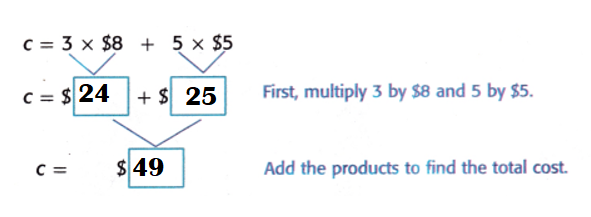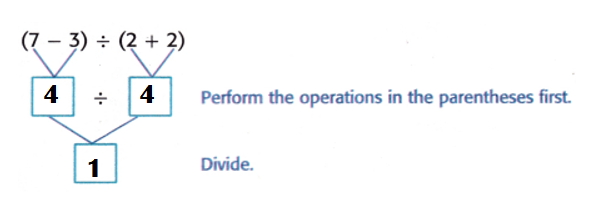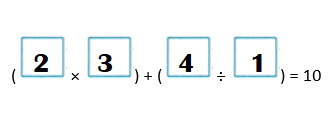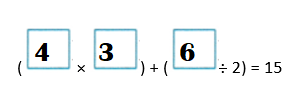All the solutions provided in McGraw Hill My Math Grade 4 Answer Key PDF Chapter 7 Lesson 7 Order of Operations will give you a clear idea of the concepts.
McGraw-Hill My Math Grade 4 Answer Key Chapter 7 Lesson 7 Order of Operations
An expression is a combination of numbers, variables, and at least one operation.
When an expression has more than one operation, the order of operations tells us which one to perform first, so that everyone gets the same answer. Parentheses () are symbols which indicate how to group operations.
Math in My World
Example 1
The table shows how much movie tickets cost. How much will it cost to buy 3 adult tickets and 5 child tickets?


cost = 3 adult tickets + 5 child tickets

So, the total cost is $____________.
Answer:
Total cost to buy 3 adult tickets and 5 child tickets = $49.

Explanation:
Cost of movie ticket for an adult = $8.
Number of adults = 3.
Cost of movie ticket for a child = $5.
Number of children = 5.
Total cost of movie ticket for an adults = Number of adults × Cost of movie ticket for an adult
= 3 × $8
= $24.
Total cost of movie ticket for children = Number of children × Cost of movie ticket for a child
= 5 × $5
= $25.
Total cost to buy 3 adult tickets and 5 child tickets = Total cost of movie ticket for an adults + Total cost of movie ticket for children
= $24 + $25
= $49.
Remember, an expression is a combination of numbers, variables, and at least one operation.
Example 2
Find the value of the expression 3 × (4 + 6).

So, 3 × (4 + 6) = _____________.
Answer:

So, 3 × (4 + 6) = 30.
Explanation:
Expression 3 × (4 + 6):
3 × (4 + 6)
= 3 × 10
= 30.
Example 3:
Find the value of the expression (7 – 3) ÷ (2 + 2).

So, (7 – 3) ÷ (2 + 2) = _____________.
Answer:

So, (7 – 3) ÷ (2 + 2) = 1.
Explanation:
Expression (7 – 3) ÷ (2 + 2):
(7 – 3) ÷ (2 + 2)
= 4 ÷ 4
= 1.
Talk Math
Explain why Examples 2 and 3 have different answers even though the numbers are the same.

Answer:
Examples 2 and 3 have different answers even though the numbers are the same because they both have different process to solve Example 2 Multiplication and Example 3 Division.
Explanation:
Example 2: 3 × (4 + 6) = 30.
Example 3: (7 – 3) ÷ (2 + 2) = 1.
Example 2 Multiplication and Example 3 Division.
Guided Practice
Find the value of each expression.
Question 1.
12 – 1 × 3 = _______________
Answer:
The value of 12 – 1 × 3 expression = 9.
Explanation:
12 – 1 × 3
= 12 – 3
= 9.
Question 2.
15 – 4 × 2 = _______________
Answer:
The value of 15 – 4 × 2 expression = 7.
Explanation:
15 – 4 × 2
= 15 – 8
= 7.
Question 3.
(15 – 4) × 2 = ________________
Answer:
The value of (15 – 4) × 2 expression = 22.
Explanation:
(15 – 4) × 2
= 11 × 2
= 22.
Independent Practice
Find the value of each expression.
Question 4.
8 + 5 × 2 = ________________
Answer:
The value of 8 + 5 × 2 expression = 18.
Explanation:
8 + 5 × 2
=> 8 + 10
=> 18.
Question 5.
10 – 1 × 5 = _______________
Answer:
The value of 10 – 1 × 5 expression = 5.
Explanation:
10 – 1 × 5
=> 10 – 5
=> 5.
Question 6.
4 + 6 ÷ 2 = _____________
Answer:
The value of 4 + 6 ÷ 2 expression = 7.
Explanation:
4 + 6 ÷ 2
=> 4 + 3
=> 7.
Question 7.
9 × 2 – 6 = _____________
Answer:
The value of 9 × 2 – 6 expression = 12.
Explanation:
9 × 2 – 6
=> 18 – 6
=> 12.
Question 8.
(16 + 2) ÷ 3 = ____________
Answer:
The value of (16 + 2) ÷ 3 expression = 9.
Explanation:
(16 + 2) ÷ 3
=> 18 ÷ 3
=> 9.
Question 9.
6 × (6 – 2) = ____________
Answer:
The value of 6 × (6 – 2) expression = 24.
Explanation:
6 × (6 – 2)
=> 6 × 4
=> 24.
Question 10.
(12 – 4) ÷ 4 = _______________
Answer:
The value of (12 – 4) ÷ 4 expression = 2.
Explanation:
(12 – 4) ÷ 4
=> 8 ÷ 4
=> 2.
Question 11.
12 – (4 ÷ 4) = ______________
Answer:
The value of 12 – (4 ÷ 4) expression = 11.
Explanation:
12 – (4 ÷ 4)
=> 12 – 1
=> 11.
Question 12.
(3 + 6) ÷ (3 × 1) = ______________
Answer:
The value of (3 + 6) ÷ (3 × 1) expression = 3.
Explanation:
(3 + 6) ÷ (3 × 1)
=> 9 ÷ 3
=> 3.
Question 13.
3 + (6 ÷ 3) × 1 = _______________
Answer:
The value of 3 + (6 ÷ 3) × 1 expression = 5.
Explanation:
3 + (6 ÷ 3) × 1
=> 3 + 2 × 1
=> 3 + 2
=> 5.
Algebra Use the order of operations to find the unknown in each equation.
Question 14.
5 × 4 – ![]() = 13
= 13
The unknown is ______________.
Answer:
5 × 4 – ![]() = 13.
= 13.
The unknown is 7.
Explanation:
5 × 4 – ?? = 13
=> 20 – ?? = 13
=> 20 – 13 = ??
=> 7 = ??.
Question 15.
![]() × (8 + 6) = 42
× (8 + 6) = 42
The unknown is ______________.
Answer:
![]() × (8 + 6) = 42.
× (8 + 6) = 42.
The unknown is 3.
Explanation:
?? × (8 + 6) = 42
=> ?? × 14 = 42
=> ?? = 42 ÷ 14
=> ?? = 3.
Question 16.
(2 + 1) × (9 – ![]() ) = 12
) = 12
The unknown is ______________.
Answer:
(2 + 1) × (9 – ![]() ) = 12
) = 12
The unknown is 5.
Explanation:
(2 + 1) × (9 – ??) = 12
=> 3 × (9 – ??) = 12
=> (9 – ??) = 12 ÷ 3
=> (9 – ??) = 4.
=> 9 – 4 = ??
=> 5 = ??
Question 17.
(10 ÷ 2) + (![]() + 3) = 40
+ 3) = 40
The unknown is ______________.
Answer:
(10 ÷ 2) + (![]() + 3) = 40.
+ 3) = 40.
The unknown is ______________.
Explanation:
(10 ÷ 2) + (?? + 3) = 40.
=> 5 + (?? + 3) = 40.
Problem Solving
Question 18.
Each bag of dried apples has 5 servings. Each bag of dried apricots has 3 servings. How many servings of dried fruit are in 6 bags of dried apples and 2 bags of dried apricots?

Answer:
Number of servings of dried fruit are in 6 bags of dried apples and 2 bags of dried apricots = 36.
Explanation:
Number of serving each bag of dried apples has = 5.
Number of serving each bag of dried apricots has = 3.
Number of bags of dried apples = 6.
Number of bags of dried apricots = 2.
Number of servings of dried fruit are in 6 bags of dried apples and 2 bags of dried apricots = (Number of serving each bag of dried apples has × Number of bags of dried apples) + (Number of serving each bag of dried apricots has × Number of bags of dried apricots)
= (5 × 6) + (3 × 2)
= 30 + 6
= 36.
Question 19.
Each book costs $4. How much does it cost to buy 3 books and one magazine that costs $5?
Answer:
Total cost to buy 3 books and one magazine that costs $5 = $17.
Explanation:
Cost of each book = $4.
Number of books = 3.
Cost of each magazine = $5.
Number of magazine = 1.
Total cost to buy 3 books and one magazine that costs $5 = (Cost of each book × Number of books) + (Cost of each magazine × Number of magazine)
= ($4 × 3) + ($5 × 1)
= $12 + $5
= $17.
Question 20.
Mathematical PRACTICE Use Number Sense A sandwich costs $6 and a drink costs $3. How much does it cost to buy 4 sandwiches and 4 drinks?
Answer:
Total cost to buy 4 sandwiches and 4 drinks = $36.
Explanation:
Cost of a sandwich = $6.
Number of sandwiches = 4.
Cost of a drink = $3.
Number of drinks = 4.
Total cost to buy 4 sandwiches and 4 drinks = (Cost of a sandwich × Number of sandwiches) + (Cost of a drink × Number of drinks)
= ($6 × 4) + ($3 × 4)
= $24 + $12
= $36.
HOT Problems
Question 21.
Mathematical PRACTICE Keep Trying Use each of the numbers 1, 2, 3, and 4 exactly once in the equation below to make the equation true.
(![]() ×
× ![]() ) + (
) + (![]() ÷
÷ ![]() ) = 10
) = 10
Answer:
Equation that is true:

Explanation:
Numbers 1, 2, 3, and 4 exactly once in the equation:
Equation:
(1 × 3) + (4 ÷ 2)
= 3 + 2
= 5.
(2 × 3) + (4 ÷ 1)
= 6 + 4
= 10.
Question 22.
Mathematical PRACTICE Make a Plan Find possible unknown values to make the equation true.
(![]() ×
× ![]() ) + (
) + (![]() ÷ 2) = 15
÷ 2) = 15
Answer:
Equation that’s true:

Explanation:
Numbers 1, 2, 3,4, 5, and 6 exactly once in the equation:
(?? × ??) + (?? ÷ 2) = 15.
=(1 × 5) + (4 ÷ 2)
= 5 + 2
= 7.
(3 × 2) + (6 ÷ 2)
= 6 + 3
= 9.
= (4 × 3) + (6 ÷ 2)
= 12 + 3
= 15.
Question 23.
Building on the Essential Question Why is knowing the order of operations important?
Answer:
The order of operations is important because it guarantees that people can all read and solve a problem in the same way.
Explanation:
The order of operations is a group of rules that tells you the right order in which to solve different parts of a math problem. Order of operations is important because it guarantees that people can all read and solve a problem in the same way.
McGraw Hill My Math Grade 4 Chapter 7 Lesson 7 My Homework Answer Key
Practice
Find the value of each expression.
Question 1.
5 + 9 ÷ 3 = _____________
Answer:
The value of 5 + 9 ÷ 3 expression = 8.
Explanation:
5 + 9 ÷ 3
= 5 + 3
= 8.
Question 2.
46 – (6 × 5) = _______________
Answer:
The value of 46 – (6 × 5) expression = 16.
Explanation:
46 – (6 × 5)
= 46 – 30
= 16.
Question 3.
(3 + 1) + 27 ÷ 9 = _______________
Answer:
The value of (3 + 1) + 27 ÷ 9 expression = 7.
Explanation:
(3 + 1) + 27 ÷ 9
= (3 + 1) + 3
= 4 + 3
= 7.
Question 4.
5 × 5 – 8 = ________________
Answer:
The value of 5 × 5 – 8 expression = 17.
Explanation:
5 × 5 – 8
= 25 – 8
= 17.
Question 5.
(4 + 20) ÷ 2 + 6 = ________________
Answer:
The value of (4 + 20) ÷ 2 + 6 expression = 18.
Explanation:
(4 + 20) ÷ 2 + 6
= 24 ÷ 2 + 6
= 12 + 6
= 18.
Question 6.
2 × 9 + 14 ÷ 2 = _________________
Answer:
The value of 2 × 9 + 14 ÷ 2 expression = 25.
Explanation:
2 × 9 + 14 ÷ 2
= 2 × 9 + 7
= 18 + 7
= 25.
Problem Solving
Question 7.
Mathematical PRACTICE Model Math Tami buys two books that cost $14 each. She pays an additional $2 in tax. How much did Tami pay altogether?
Answer:
Total amount of money Tami pay altogether = $30.
Explanation:
Cost of each book = $14.
Number of books = 2.
Amount of money she pays an additional in tax = $2.
Total amount of money Tami pay altogether = (Cost of each book × Number of books) + Amount of money she pays an additional in tax
= ($14 × 2) + $2
= $28 + $2
= $30.
Question 8.
Claudio had 34 toy cars. He lost two at the park. Then he divided the rest of the cars evenly among himself and 3 cousins. How many cars did each child get?
Answer:
Number of toy cars each child get = 8.
Explanation:
Number of toy cars Claudio had = 34.
Number of toy cars he lost in the park = 2.
Number of people he divided them equally = 4.
Number of toy cars each child get = (Number of toy cars Claudio had – Number of toy cars he lost in the park) ÷ Number of people he divided them equally
= (34 – 2) ÷ 4
= 32 ÷ 4
= 8.
Question 9.
Last week, Jean did two sit-ups on Monday and three sit-ups on Wednesday. This week, Jean did three times as many sit-ups as last week How many sit-ups did Jean do this week?
Answer:
Number of sit ups Jean did this week = 15.
Explanation:
Number of sit-ups on Monday Jean did = 2.
Number of sit-ups on Wednesday Jean did = 3.
This week, Jean did three times as many sit-ups as last week.
Number of sit ups Jean did this week = 3 × (Number of sit-ups on Monday Jean did + Number of sit-ups on Wednesday Jean did)
= 3 × (2 + 3)
= 3 × 5
= 15.
Test Practice
Question 10.
Which expression has a value of 20?
(A) 2 × 5 + 5
(B) 3 × (5 + 5)
(C) 3 × 7 – 1
(D) 40 ÷ 5 – 3
Answer:
3 × 7 – 1 expression has a value of 20.
(C) 3 × 7 – 1
Explanation:
(A) 2 × 5 + 5 = 10 + 5 = 15.
(B) 3 × (5 + 5) = 3 × 10 = 30.
(C) 3 × 7 – 1 = 21 -1 = 20.
(D) 40 ÷ 5 – 3 = 8 – 3 = 5.